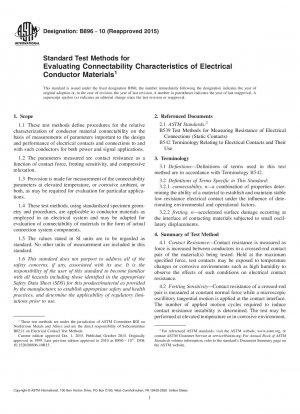ASTM B896-10(2015)
Standard Test Methods for Evaluating Connectability Characteristics of Electrical Conductor Materials
- Standard No.
- ASTM B896-10(2015)
- Release Date
- 2010
- Published By
- American Society for Testing and Materials (ASTM)
- Status
- Replace By
- ASTM B896-10(2020)
- Latest
- ASTM B896-10(2020)
- Scope
5.1 These test methods develop comparative information useful for the design of stationary contacts for wire, cable, and other conductors.
5.2 These test methods produce results, which are free of the influence of arbitrary connection systems.
5.3 The influence of conductor surface pretreatments and platings can be evaluated by these test methods.
5.4 The influence of environmental factors, such as high temperature and corrosive environment can be evaluated by these test methods.
5.5 The results obtained by these test methods provide guidance on connection system design parameters, such as contact force and gas tightness requirements.
1.1 These test methods define procedures for the relative characterization of conductor material connectability on the basis of measurements of parameters important to the design and performance of electrical contacts and connections to and with such conductors for both power and signal applications.
1.2 The parameters measured are contact resistance as a function of contact force, fretting sensitivity, and compressive relaxation.
1.3 Provision is made for measurement of the connectability parameters at elevated temperature, or corrosive ambient, or both, as may be required for evaluation for particular applications.
1.4 These test methods, using standardized specimen geometry and procedures, are applicable to conductor materials as employed in an electrical system and may be adapted for evaluation of connectability of materials in the form of actual connection system components.
1.5 The values stated in SI units are to be regarded as standard. No other units of measurement are included in this standard.
1.6 This standard does not purport to address all of the safety concerns, if any, associated with its use. It is the responsibility of the user of this standard to become familiar with all hazards including those identified in the appropriate Safety Data Sheet (SDS) for this product/material as provided by the manufacturer, to establish appropriate safety and health practices, and determine the applicability of regulatory limitations prior to use.
ASTM B896-10(2015) Referenced Document
- ASTM B539 Standard Test Methods for Measuring Resistance of Electrical Connections (Static Contacts)
- ASTM B542 Standard Terminology Relating to Electrical Contacts and Their Use
ASTM B896-10(2015) history
- 2020 ASTM B896-10(2020) Standard Test Methods for Evaluating Connectability Characteristics of Electrical Conductor Materials
- 2010 ASTM B896-10(2015) Standard Test Methods for Evaluating Connectability Characteristics of Electrical Conductor Materials
- 2010 ASTM B896-10e1 Standard Test Methods for Evaluating Connectability Characteristics of Electrical Conductor Materials
- 2010 ASTM B896-10 Standard Test Methods for Evaluating Connectability Characteristics of Electrical Conductor Materials
- 1999 ASTM B896-99(2005) Standard Test Methods for Evaluating Connectability Characteristics of Electrical Conductor Materials
- 1999 ASTM B896-99 Standard Test Methods for Evaluating Connectability Characteristics of Electrical Conductor Materials
